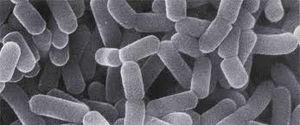Lactobacillus sanfranciscensis: Difference between revisions
No edit summary |
|||
| Line 17: | Line 17: | ||
<br><b>Superscript:</b> Fe<sup>3+</sup> | <br><b>Superscript:</b> Fe<sup>3+</sup> | ||
<br>Lactobacillus sanfranciscensis is a rod-shaped, Gram positive, lactic acid bacteria, closely related to the Lactobacillus casei-Pediococcus group. It is nonsporulating, nonrespiring, acid- and aero-tolerant. Famous for being an important flavor component of sourdough bread, Lb. sanfranciscensis is an obligate, heterofermentative bacteria. Its fastidiousness arises from a symbiotic relationship with Saccharomyces cerevisiae. This yeast, also useful in the making of sourdough, provides Lb. sanfranciscensis with amino acids and peptides to aid in growth and fermentation. During fermentation, the microbe consumes maltose and glucose to ultimately release acids that create the sour taste in sourdough. | <br>Lactobacillus sanfranciscensis is a rod-shaped, Gram positive, lactic acid bacteria, closely related to the Lactobacillus casei-Pediococcus group. It is nonsporulating, nonrespiring, acid- and aero-tolerant. Famous for being an important flavor component of sourdough bread, Lb. sanfranciscensis is an obligate, heterofermentative bacteria. Its fastidiousness arises from a symbiotic relationship with Saccharomyces cerevisiae. This yeast, also useful in the making of sourdough, provides Lb. sanfranciscensis with amino acids and peptides to aid in growth and fermentation. During fermentation, the microbe consumes maltose and glucose to ultimately release acids that create the sour taste in sourdough.<ref>[https://www.ncbi.nlm.nih.gov/pmc/articles/PMC3231932/pdf/1475-2859-10-S1-S6.pdf : Vogel RF, Pavlovic M, Ehrmann MA, et al. Genomic analysis reveals Lactobacillus sanfranciscensis as stable element in traditional sourdoughs. Microbial Cell Factories. 2011.]</ref><br> | ||
<br> | |||
Introduce the topic of your paper. What is your research question? What experiments have addressed your question? Applications for medicine and/or environment?<br> | Introduce the topic of your paper. What is your research question? What experiments have addressed your question? Applications for medicine and/or environment?<br> | ||
Sample citations: <ref>[http://www.plosbiology.org/article/fetchObject.action?uri=info%3Adoi%2F10.1371%2Fjournal.pbio.1000005&representation=PDF Hodgkin, J. and Partridge, F.A. "<i>Caenorhabditis elegans</i> meets microsporidia: the nematode killers from Paris." 2008. PLoS Biology 6:2634-2637.]</ref> | Sample citations: <ref>[http://www.plosbiology.org/article/fetchObject.action?uri=info%3Adoi%2F10.1371%2Fjournal.pbio.1000005&representation=PDF Hodgkin, J. and Partridge, F.A. "<i>Caenorhabditis elegans</i> meets microsporidia: the nematode killers from Paris." 2008. PLoS Biology 6:2634-2637.]</ref> | ||
Revision as of 14:34, 17 April 2018
Section
By [Kay Burrows]
At right is a sample image insertion. It works for any image uploaded anywhere to MicrobeWiki.
The insertion code consists of:
Double brackets: [[
Filename: PHIL_1181_lores.jpg
Thumbnail status: |thumb|
Pixel size: |300px|
Placement on page: |right|
Legend/credit: Electron micrograph of the Ebola Zaire virus. This was the first photo ever taken of the virus, on 10/13/1976. By Dr. F.A. Murphy, now at U.C. Davis, then at the CDC.
Closed double brackets: ]]
Other examples:
Bold
Italic
Subscript: H2O
Superscript: Fe3+
Lactobacillus sanfranciscensis is a rod-shaped, Gram positive, lactic acid bacteria, closely related to the Lactobacillus casei-Pediococcus group. It is nonsporulating, nonrespiring, acid- and aero-tolerant. Famous for being an important flavor component of sourdough bread, Lb. sanfranciscensis is an obligate, heterofermentative bacteria. Its fastidiousness arises from a symbiotic relationship with Saccharomyces cerevisiae. This yeast, also useful in the making of sourdough, provides Lb. sanfranciscensis with amino acids and peptides to aid in growth and fermentation. During fermentation, the microbe consumes maltose and glucose to ultimately release acids that create the sour taste in sourdough.[1]
Introduce the topic of your paper. What is your research question? What experiments have addressed your question? Applications for medicine and/or environment?
Sample citations: [2]
[3]
A citation code consists of a hyperlinked reference within "ref" begin and end codes.
Section 1
Include some current research, with at least one figure showing data.
Every point of information REQUIRES CITATION using the citation tool shown above.
Section 2
Include some current research, with at least one figure showing data.
Section 3
Include some current research, with at least one figure showing data.
Section 4
Conclusion
References
- ↑ : Vogel RF, Pavlovic M, Ehrmann MA, et al. Genomic analysis reveals Lactobacillus sanfranciscensis as stable element in traditional sourdoughs. Microbial Cell Factories. 2011.
- ↑ Hodgkin, J. and Partridge, F.A. "Caenorhabditis elegans meets microsporidia: the nematode killers from Paris." 2008. PLoS Biology 6:2634-2637.
- ↑ : Vogel RF, Pavlovic M, Ehrmann MA, et al. Genomic analysis reveals Lactobacillus sanfranciscensis as stable element in traditional sourdoughs. Microbial Cell Factories. 2011.
Authored for BIOL 238 Microbiology, taught by Joan Slonczewski, 2018, Kenyon College.

